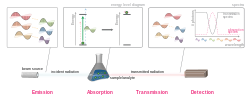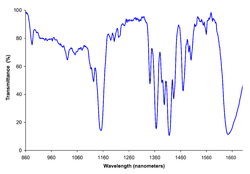Ultraviolet–visible spectrophotometry (UV–Vis or UV-VIS) refers to absorption spectroscopy or reflectance spectroscopy in part of the ultraviolet and...
34 KB (4,440 words) - 01:30, 8 May 2025
present. Infrared and ultraviolet–visible spectroscopy are particularly common in analytical applications. Absorption spectroscopy is also employed in studies...
22 KB (2,574 words) - 20:50, 18 March 2025
Ultraviolet–visible spectroscopy (UV–vis) can distinguish between enantiomers by showing a distinct Cotton effect for each isomer. UV–vis spectroscopy...
2 KB (218 words) - 20:01, 19 October 2024
common types of spectroscopy include atomic spectroscopy, infrared spectroscopy, ultraviolet and visible spectroscopy, Raman spectroscopy and nuclear magnetic...
44 KB (4,768 words) - 18:59, 23 May 2025
Variable pathlength cell (redirect from Slope Spectroscopy)
variable pathlength cell is a sample holder used for ultraviolet–visible spectroscopy or infrared spectroscopy that has a path length that can be varied to change...
7 KB (904 words) - 10:50, 19 October 2024
Instrumental chemistry (section Spectroscopy)
absorption spectroscopy, atomic emission spectroscopy, ultraviolet-visible spectroscopy, X-ray fluorescence spectroscopy, infrared spectroscopy, Raman spectroscopy...
8 KB (833 words) - 00:58, 11 October 2022
predator detection. Spectroscopy is the study of objects based on the spectrum of color they emit, absorb or reflect. Visible-light spectroscopy is an important...
37 KB (4,038 words) - 05:46, 31 May 2025
spectroscopists used wavelength (nm), as is used in ultraviolet–visible spectroscopy. Early practitioners of IR spectroscopy, who depended on assignment of absorption...
31 KB (3,792 words) - 00:57, 26 February 2025
focuses on developing ultraviolet (UV) detector technology, ultraviolet–visible spectroscopy (UV/VIS) instrumentation and spectroscopy, and galaxy evolution...
14 KB (1,271 words) - 14:25, 10 March 2025
Absorption (electromagnetic radiation) (category Spectroscopy)
few examples of absorption are ultraviolet–visible spectroscopy, infrared spectroscopy, and X-ray absorption spectroscopy. Understanding and measuring the...
9 KB (806 words) - 11:47, 20 April 2025
necessarily, visible light. A complementary technique is absorption spectroscopy. In the special case of single molecule fluorescence spectroscopy, intensity...
22 KB (2,841 words) - 10:23, 24 May 2025
Spectrometer (section Magnetic resonance spectroscopy)
refraction in a prism or by diffraction by a diffraction grating. Ultraviolet–visible spectroscopy is an example. These spectrometers utilize the phenomenon of...
16 KB (1,072 words) - 11:42, 13 March 2025
equivalent. Molecular orbital theory is used to interpret ultraviolet–visible spectroscopy (UV–VIS). Changes to the electronic structure of molecules...
28 KB (3,710 words) - 11:02, 31 May 2025
Soret peak (category Absorption spectroscopy)
analytical studies of porphyrin‑containing moiety can be done using ultraviolet–visible spectroscopy and exciting wavelength at the respective Soret band wavelength...
3 KB (292 words) - 12:53, 3 December 2023
Ultraviolet radiation, also known as simply UV, is electromagnetic radiation of wavelengths of 10–400 nanometers, shorter than that of visible light, but...
125 KB (13,500 words) - 00:04, 3 June 2025
Absorbance (category Spectroscopy)
plotted on a graph of absorbance vs. wavelength. An Ultraviolet-visible spectroscopy#Ultraviolet–visible spectrophotometer will do all this automatically...
21 KB (2,921 words) - 18:00, 10 February 2025
Light (redirect from Visible light)
750–420 terahertz. The visible band sits adjacent to the infrared (with longer wavelengths and lower frequencies) and the ultraviolet (with shorter wavelengths...
53 KB (6,543 words) - 22:33, 3 April 2025
(DRIFTS) and diffuse-reflectance ultraviolet–visible spectroscopy. The mathematical treatments of absorption spectroscopy for scattering materials were originally...
37 KB (5,382 words) - 18:47, 23 May 2025
photons—are studied by X-ray astronomy and gamma-ray astronomy. Ultraviolet light is not visible to the human eye. Most of the light at these wavelengths is...
9 KB (863 words) - 04:03, 27 February 2025
to changes in their absorption properties (recorded using ultraviolet–visible spectroscopy), such as in absorption intensity and wavelength or in chirality...
45 KB (5,025 words) - 21:33, 29 May 2025
Glass: Uses of NMR Spectroscopy in the Analysis and Synthesis of Chiral Pharmaceuticals." 1994. [2] Ultraviolet-visible spectroscopy of stereoisomers v...
2 KB (257 words) - 19:19, 18 July 2023
testing, specifically when recording absorbance readings from Ultraviolet-visible Spectroscopy, since thicker films have lower optical transmittance and typically...
7 KB (852 words) - 18:14, 30 March 2025
Solar-blind technology (redirect from Solar-blind ultraviolet photodetector)
Semiconductor ultraviolet detectors are solid state, and convert an ultraviolet photon into an electric pulse. If they are transparent to visible light, then...
6 KB (786 words) - 20:26, 26 January 2025
spectroscopy is the study of astronomy using the techniques of spectroscopy to measure the spectrum of electromagnetic radiation, including visible light...
47 KB (5,318 words) - 13:55, 23 February 2025
Analytical chemistry (section Spectroscopy)
absorption spectroscopy, atomic emission spectroscopy, ultraviolet-visible spectroscopy, X-ray spectroscopy, fluorescence spectroscopy, infrared spectroscopy, Raman...
36 KB (4,120 words) - 01:54, 26 May 2025
optical rotatory dispersion, vibrational circular dichroism, ultraviolet-visible spectroscopy, the use of chiral shift reagents in proton NMR and Coulomb...
16 KB (1,799 words) - 20:16, 23 April 2025
determination of molecular structures. Various forms of spectroscopy: Ultraviolet-visible spectroscopy: Historically, this has been an important tool, since...
30 KB (3,224 words) - 15:33, 23 May 2025
Electromagnetic radiation (section Visible light)
wavelength, ranging from radio waves, microwaves, infrared, visible light, ultraviolet, X-rays, and gamma rays. All forms of EMR travel at the speed...
85 KB (10,023 words) - 00:11, 25 May 2025
Electromagnetic spectrum (redirect from Low visible light)
high frequency these are: radio waves, microwaves, infrared, visible light, ultraviolet, X-rays, and gamma rays. The electromagnetic waves in each of...
47 KB (4,685 words) - 15:35, 12 May 2025
microanalysis include: Most of the spectroscopy methods: ultraviolet–visible spectroscopy, infrared spectroscopy, nuclear magnetic resonance, X-ray fluorescence...
2 KB (215 words) - 14:03, 19 October 2023



















